Vidar and Vali
The Wolf and the Vé
by Peter Krüger
©2014
[Germanic Astronomy]
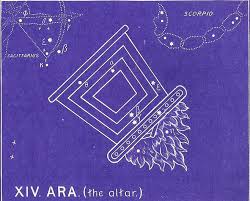 |
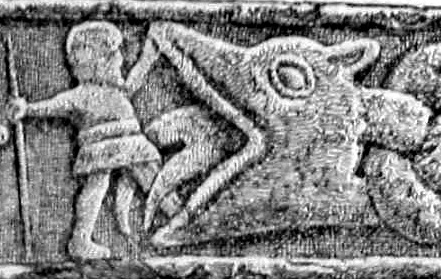 |
 |
|
"Víðarr ok Váli |
"Vidar and Vali inhabit the vé of the gods' when Surt's fire slackens." |
Translators are uncertain of how to best translate the phrase ‘vé goda’. One find various attempts such as "gods’ home", "deities shrines", "temple", "wih-stead" in the published translations of Vafthrudnismal. Undoubtedly, the word was chosen by the poet in this context because of the alliteration with the names Vidar and Vali.
Perhaps the most accurate translation of vé is "wih-stead" (holy place) or the German ‘Weihtum’, thus the Felix Genzmer translation reads:
|
Widar and Wali |
“Víðarr and Váli shall dwell in the gods’ wih-stead when Surtr’s fire is slaked”. |
Weihtum is a poetic form for Heiligtum, sanctuary. The word ‘weihen’ is used in many compositions such as Weihnachten, Altarweihe or Weihaltar. The Nordic word for altar is normally hörg and appears in both of the poems Vafthrudnismal and Völuspa in the phrase: "hofum ok hörgum" (Vafthrudnismal 38) and "hörg ok hof‘ (Völuspá 7).
Could vé be a variant of "hörg ok hof"?
If we assume an astronomical background of the vé and search the Greek astronomical sources for a sanctuary, there is just one candidate— the constellation Ara:
"Ara represents the heavenly Altar created by the gods of Mount Olympus to celebrate the defeat of the titans where the gods swore their allegiance to the supreme god Zeus (Jupiter). The smoke from the altar was said to pour out to create the Milky Way."
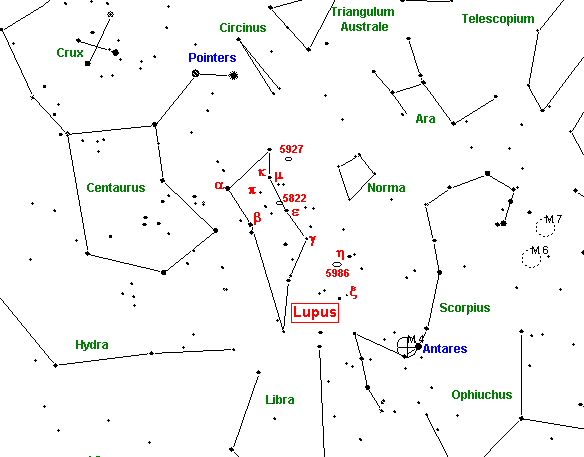 |
"According to another account Ara was the altar on which the Centaur (Centaurus) offered his sacrifice of Lupus. Centaurus is traditionally depicted as carrying Lupus, the Wolf, to sacrifice on Ara, the altar. Ara was also known as the altar that Noah built after the great flood when his ark rested on Mt. Ararat.“
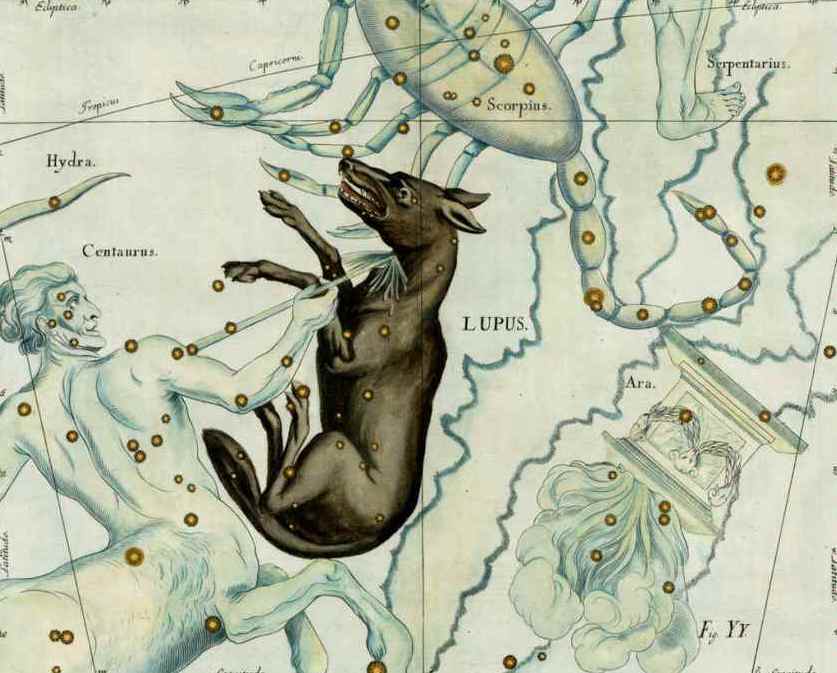 |
This is of interest for the current investigation, because Vidar is known from Völuspa to slaughter a wolf or, to be more correct, a valdýri.
|
"Þá kemr inn mikli
|
"Then comes the
great son of Victory-Father, Vidar, to smite the carrion beast." (Bernard Scudder tr.) |
And Vali, the son of Loki, is said to have been changed into a wolf (vargr) in Gylfaginning.
|
"Þá váru teknir synir Loka, Váli ok Nari eða Narfi. Brugðu æsir Vála í vargslíki ok reif hann í sundr Narfa, bróður sinn."
|
Then were taken Loki's sons, Vali and Nari or Narfi; the Æsir changed Váli into the form of a wolf, and he tore asunder Narfi his brother.‘ (Arthur Brodeur tr.) |
‚
Therefore, in one stanza of Vafthrudnismal, we find a sanctuary, a wolf-slayer and a wolf just as in the Greek account concerning Ara.
Can this be a coincidence?
Is there a connection between valdýri and Váli? Do both reappear after a flood just as Hödur and Baldur do? We should also keep in mind that Völuspa contains a flood myth, given as a reason to build an altar in ancient myths. When the burnt crust of the earth consumed by Surt's fire sinks into the sea, a new world arises, teeming with life.
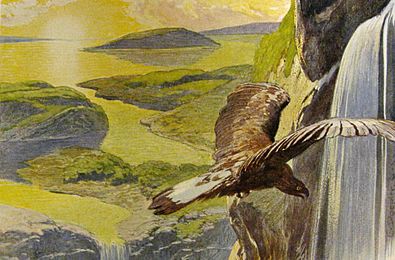 |
Interestingly, I also came independently to the conclusion that Widga/Witege, the hero of the Dietrich cycle has a connection to the constellation Centaur. A connection between Vidar and Widga has long been assumed.
Now, I’d like to follow up on the ideas I expressed above about the identity of Váli, Vidar and the Vé in a stanza of Vafthrudnismál. I have explained them as the group of constellations:
Lupus, the w
olf =Váli,Centaurus, the horseman =Vidar
and Ara, the altar =Vé.
If we follow the common emendation of ‘vel’ to ‘vé’ in Völuspá 62, we would find a very similar phrase "vé valtiva", instead of the ‘vé goda’ in Vafthrudnismál:
|
Of course it would be obvious to equate the valtiva with goda and to understand both as Aesir. However, I would like to propose a different translation.
Already upon first glance at the word valtivar, we again encounter the word stem ‘vál’ as in Váli and valdyri, but who are these aforementioned valtivar?
The word is translated in many different ways, such as: "gods of slaughter" (Larrington), "war-gods" (Hollander), "wise gods"(Auden/Taylor), "gods of the sanctuary" (Dronke), etc.
Let’s look again at the two constellations of Centaurus and Lupus. According to Aratus (Phainomena), the Centaur is grasping Lupus and both are closely connected to the altar:
|
[436] "The constellation of Centaur [Centaurus] thou wilt find beneath two others. For part in human form lies beneath Scorpio, but the rest, a horse’s trunk and tail, are beneath the Claws. He ever seems to stretch his right hand towards the round Altar, but though his hand is drawn and firmly grasped another sign – the Beast [Fera, Lupus], for so men of old have named it." |
Is it possible that Centaur and Lupus are seen together here as one constellation named valtivar, "the fighting gods"?! To properly analyze this theory, it is necessary to look at the second occurance of the name valtivar in Völuspá:
|
Surtr ferr sunnan með sviga lævi, skínn af sverði sól valtíva. Griótbjörg gnata, en gífr rata, troða halir helveg, en himinn klofnar. |
Surt fares
from the south with the scourge of branches, The sun of the battle-gods shone from his sword; The crags are sundered, the giant-women sink, The dead throng Hel-way, and heaven is cloven. |
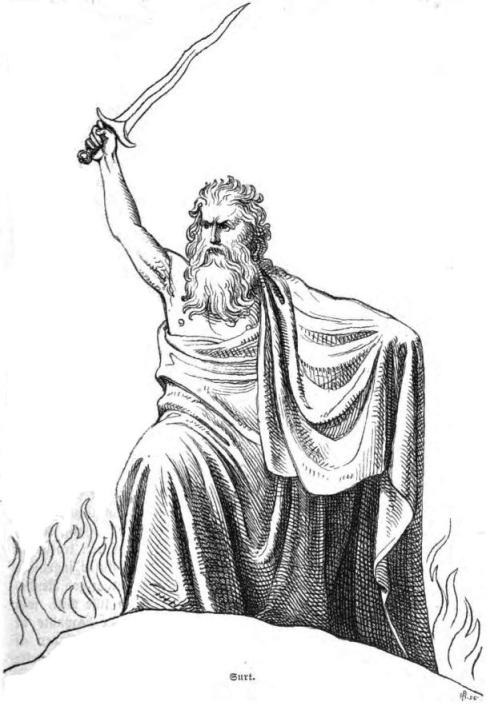 |
I have already explained my interpretation of the other elements of this stanza in previous posts:
The helveg seems to be the Milky Way starting from at least the crossing of Milky Way and ecliptic up to Cygnus and Lyra.
Griotbjörg is the Milky Way in the Sagittarius/Scorpio area.
The term himinn klofnar might refer to the Great Rift of the Milky Way.
The sverði, sword, is the stinger of Scorpio.
The sviga laevi, "bane of branches" (fire) represents Ara the altar (!).
According to Aratus, Ara and Centaur are located in the southern region of heaven. Gifr might be Lupus (compare the hound Gifur in Fjölsvinnsmál) or even more probable— the star Antares in Scorpio, also representing Modgudr at the entrance to Hel.
Surtr, the Black, might be the opposite of a constellation, i.e. a black cloud, also called a black constellation. Particularly in this region of sky we find the most dark clouds. The most prominent of them is the Coalsack, a region within the borders of the constellation Centaur. (I would suggest the same explanation as dark clouds for the dark elves and black elves).
So indeed, everything points exactly to the region of Ara, Centaur and Lupus. But how can we explain the phrase sol valtiva? What would be the connection of the valtivar, i.e. Centaur and Lupus, with the sun? There is one possibility.
If we compare the Greek Lupus and Centaur with Babylonian star lore, we find instead two constellations called the Mad Dog and the Bison-man. Both are depicted as fighting with one another. In Babylonian mythology, this is known as the lion-bull conflict and is closely associated with the sun god Shamash.
Compare this to the book ‘Babylonian Star Lore’ written by Gavin White, a work I highly recommend:
|
“…the Bison-man starts to appear in the retinue of the sun god, and is in particular, portrayed as his doorkeeper. Essentially the Bison-man’s role as doorkeeper is to regulate order and maintain peace and justice, which are the natural and well-attested attributes of the sun god. Like the Scorpion-men of the Epic of Gilgamesh who guard the mountain of the sunrise and sunset, the Bison-man stands before the gates of the sun, regulating his passage through heaven and the underworld, a theme that is especially related to the autumn equinox.”
“…the ‘great bison, son of Ningirsu’ as doorkeeper to the inner sanctuary of the temple.”
“…where the deity ‘Bison, son of Shamash’ appears as the god before the accuser swears in witchcraft trials.” |
Vituð ér enn, eða hvat ?
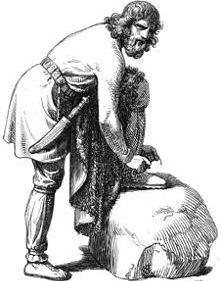 |
 |
Gylfaginning preserves a strange story about the fight between Vidar and the wolf (Brodeur Translation):
"The Wolf shall swallow Odin; that shall be his ending. But straight thereafter shall Vídarr stride forth and set one foot upon the lower jaw of the Wolf: on that foot he has the shoe, materials for which have been gathering throughout all time. (They are the scraps of leather which men cut out: of their shoes at toe or heel; therefore he who desires in his heart to come to the Æsir's help should cast those scraps away.) With one hand he shall seize the Wolf's upper jaw and tear his gullet asunder; and that is the death of the Wolf."
In another passage we read:
"Vídarr is the name of one, the silent god. He has a thick shoe."
In addition we find in Skáldskaparmál the following Vidar-kennings:
"How should one periphrase Vídarr? He maybe called the Silent God, Possessor of the Iron Shoe (járnskós), Foe and Slayer of Fenris-Wolf, Avenger of the Gods, Divine Dweller in the Homesteads of the Fathers, Son of Odin, and Brother of the Æsir."
An iron shoe? This is unusal - unless you are a horse. The iron shoe might lead us to a surprising explanation. I argued above that it is possible to identify Vidar astronomically as a horseman, the centaur, Centaurus, next to Lupus the wolf. Indeed the Centaur is stretching his hand out to grasp the wolf (compare Aratus, Phainomena).
So what about the shoe?
The brightest star of Centaurus, Toliman, better known as Alpha Centauri bears also the name Rigil Kentaurus, the Centaur's foot at the right front hoof of the Centaur. Toliman is the fourth brightest star on heaven and very easy to detect in southern hemispheres.
The iron shoe of Vidar might therefore be in fact a horseshoe! (compare German Hufeisen, literally 'hoof-iron'). It can also be made from leather (like a hipposandal) or of course, as in this context no horse is mentioned it's simply the very noticable shoe of Vidar.
The wolf, by the way, might have been much bigger than today's constellation of Lupus.